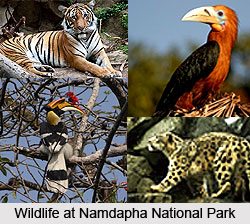 Namdapha National Park, situated in the Changlang district of the northeast Indian state of Arunachal Pradesh is accredited as the largest protected area in the Eastern Himalaya biodiversity hotspot. In terms of area, it is the third largest national park in India. Spanning over the Eastern Himalayan sub-region, the place is famed for hosting one of the richest areas of biodiversity in the country. Namdapha National Park hosts the northernmost lowland evergreen rainforests. The region is also recognized as extensive Dipterocarp forests. The park hosts a few settlements belonging to Lisu tribe. Most of them dwell towards the eastern border of the park. Apart from them, Singpho, Tangsa and Chakma tribes also dwell here.
Namdapha National Park, situated in the Changlang district of the northeast Indian state of Arunachal Pradesh is accredited as the largest protected area in the Eastern Himalaya biodiversity hotspot. In terms of area, it is the third largest national park in India. Spanning over the Eastern Himalayan sub-region, the place is famed for hosting one of the richest areas of biodiversity in the country. Namdapha National Park hosts the northernmost lowland evergreen rainforests. The region is also recognized as extensive Dipterocarp forests. The park hosts a few settlements belonging to Lisu tribe. Most of them dwell towards the eastern border of the park. Apart from them, Singpho, Tangsa and Chakma tribes also dwell here.
History of Namdapha National Park
Namdapha was officially announced as a wildlife sanctuary in the year 1972 and a national park in 1983. Then it became a tiger reserve under the Project Tiger scheme in the same year. The name of this national park has been derived from two Singpho words- "nam" means water and "dapha" means origin. The word "origin" refers to the originating point of river from Dapha Bum glaciers.
Geography of Namdapha National Park
Namdapha National Park encompasses an area of 1985 square kilometers including 177 square kilometers of buffer zone and 1808 square kilometers of core area. It is nestled between the Patkai range and the Mishmi hills. The altitude of the park has wide variations which range from 200 meters to 4571 meters above sea level.
Flora of Namdapha National Park
Namdapha National Park is included in Indo Malayan and Palearctic bio-geographic areas which constitutes a vast assortment of biological species. The habitat of the region changes with increasing altitude. At higher elevations alpine meadows are dominant while at lower altitudes temperate forests, montane forests and tropical moist forests are found. Bamboo forests are also spread extensively in the park.
 Fauna of Namdapha National Park
Fauna of Namdapha National Park
Namdapha flying squirrel was first collected in the park. It is endemic to the park and critically endangered. It was last recorded in 1981 in a single valley within the park. Namdapha National Park is also the abode of a rich diversity of mammals owing to its varied vegetation zones. Common species found here include Tigers, Common Leopards, Clouded Leopards, Snow Leopards and others. Large predators of the forest include Asiatic Black Bear, Wolves and Dholes. Mongoose, Asiatic Golden Cat, Fishing Cat, Marbled Cat, Masked Palm Civet, Large Indian Civet, Small Indian Civet, Common Palm Civet, Binturong, Red Panda etc. are the smaller carnivores. Mainland Serow, Common Goral, Gaur, Elephants, Sambar, Hog Deer, Indian Muntjac, Forest Musk Deer are the representatives of large herbivores. Non-human primates of the region include seven species namely Rhesus Macaques, Assamese Macaques, Capped Langurs, Hoolock Gibbons, Slow Loris and Stump-tailed Macaque.
Avifauna of Namdapha National Park
Namdapha National Park is the home to about 425 bird species. Globally endangered species of birds include Whitecheeked Hill Partridge, Himalayan Wood-Owl, White-Winged Wood Duck, Pied Falconet, Blue-Eared Kingfisher, Ward`s Trogon, Beautiful Nuthatch and many more. Migratory birds like Thrushes and Amur Falcon can also be spotted here. Numerous species of rare Wren-Babblers are also the inhabitants of Namdapha National Park. Five species of Hornbill have been recorded here. Other common birds found here include Scimitar Babblers, Shrike Babblers, Fulvettas, Parrotbills, Laughing Thrushes etc. A critically endangered species called White-bellied Heron was spotted here for the first time in 1994.
Visiting Information on Namdapha National Park
Nearest airports of Changlang District are located at Dibrugarh, Assam. Nearest railheads are Tinsukia Railway Station and Margherita Railway Station.



















